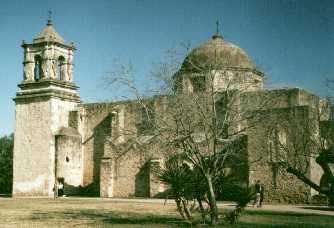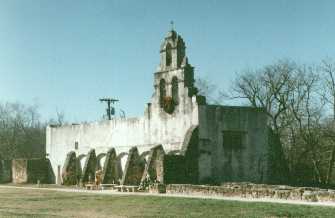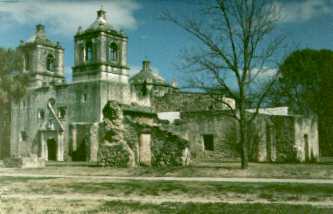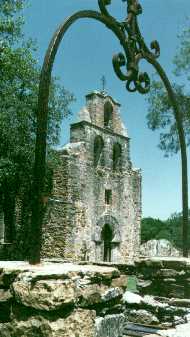|
|
||||
 |
||||
The Five Spanish Missions of Old San Antonio
A chain of five missions established along the San Antonio River in the 18th century became the largest concentration of Catholic missions in North America. Built primarily to expand Spanish New World influence northward from Mexico, the missions also served to introduce native inhabitants into Spanish society.
From 1718 through 1731 five missions which drew their members from mostly weaker groups were established near the head of the San Antonio River. The first was San Antonio de Valero,qv which dated from the origins of the settlement. It was followed by San José y San Miguel de Aguayo, Nuestra Señora de la Purísima Concepción,qv San Juan Capistrano,qv and San Francisco de la Espada.qv In varying degrees, these foundations developed as true missionary-directed indigenous towns, whose material success was evident in their churches, dwellings, granaries, workshops, irrigated fields, ranches and livestock, and a regulated social and religious life. The San Antonio settlement comprised the missions, San Antonio de Béxar Presidio,qv and the town of San Fernando de Béxar.qv The area was developed enough that the missions had protection and resources to develop their own stability within a gradually coalescing community. However, the immediate proximity of the town and presidio obliged the Franciscans to engage in a losing battle to maintain strict control over the missionized Indians' relations with their neighbors. By the later 1700s the permanent Indian residents of the San Antonio missions were speaking Spanish, living as devoted Catholics, and even intermarrying with the local Hispanics. Other Indians, both local and from elsewhere, had become part of the town itself.
Four of the missions (San Jose, San Juan, Concepcion, and Espada) were originally founded in East Texas. As the East Texas missions succumbed to drought, malaria, and French incursions, however, they were relocated to San Antonio.
The missions flourished during the middle of the 18th century, but later declined due to inadequate military support, disease, and increased hostilities with Apaches and Comanches.

The Alamo (1718)
The first and today the most widely known of these
missions was San Antonio de Valero, commonly called the Alamo. It was
established in 1718 as a way station between missions already existing in East
Texas and other base missions in Mexico. It was well over 100 years old when it
became the focal point for the Battle of the Alamo, fought March 6, 1836. The
Alamo will always be remembered and associated with that battle.

San Jose (1720)
Soon after the building of the Alamo, a second mission
was founded in 1720 about five miles downstream. Named San Jose, this new
mission was established by Fray Antonio Margil de Jesus, who had previously left
a failed mission in East Texas. A model among the Texas missions, San Jose
gained a reputation as a major social and cultural center. Among the San Antonio
missions, it also provided the strongest garrison against raids from Indians.

San Juan (1731)
First established in East Texas, mission San Juan
Capistrano made its permanent home on the banks of the San Antonio River in
1731. Within a short time, the mission became a regional supplier of
agricultural and other products including iron, wood, cloth, and leather goods
produced by the Indians in its workshops. A few miles southeast of the mission
was Rancho Pataguilla, which in 1762 reported 3,500 sheep and nearly as
many cattle.

Concepcion (1731)
One of the most attractive of the San Antonio missions,
the church at Concepcion looks essentially as it did more than 200 years ago,
when it stood at the center of local religious activity. The mission was well
known for its religious celebrations. Not visible today are the colorful
geometric designs that originally covered the exterior surface of the mission.
Inside, however, are original paintings of religious symbols and architectural
designs.

Espada (1731)
Mission San Francisco de la Espada, like its sister
missions San Jose, San Juan, and Concepcion, had its beginnings in East Texas.
Originally named San Francisco de los Tejas, Espada was renamed and relocated to
San Antonio in 1731. It is the southernmost of the chain of missions located on
the San Antonio River. Mission Espada features a very attractive chapel, along
with an unusual door and stone entrance archway.